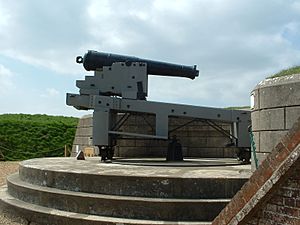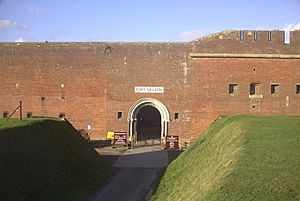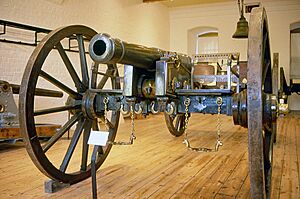Fort Nelson, Hampshire facts for kids
Quick facts for kids Fort Nelson, Hampshire |
|
|---|---|

64pdr R.M.L. on traversing carriage – part of the original armament of Fort Nelson.
|
|
| Type | Palmerston fort |
| Location | Boarhunt |
| OS grid reference | SU 60696 07203 |
| Area | Hampshire |
| Built | 1860–1867 |
| Owner | Hampshire County Council |
|
Listed Building – Grade I
|
|
| Official name: Fort Nelson, Boarhunt | |
| Designated | 22 Dec 1971 |
| Reference no. | 1350616 |
| Lua error in Module:Location_map at line 420: attempt to index field 'wikibase' (a nil value). | |
Fort Nelson is an old, strong fort located in Hampshire, England. It's one of five forts built on top of Portsdown Hill in the 1860s. These forts were made to protect the important naval base of Portsmouth from attacks. Today, Fort Nelson is a special place where the Royal Armouries keeps a huge collection of artillery (big guns and cannons) for everyone to see. It is also a Grade I Listed Building, which means it's a very important historic site.
Contents
What Does Fort Nelson Look Like?
Fort Nelson is a classic example of a "Polygonal" or "Palmerston Fort". It has six sides and is surrounded by a deep ditch. This ditch was protected by three special areas called caponiers.
Inside the Fort
- Big Guns: Above each caponier, there were protected spots for huge 13-inch mortars. These were cannons that fired shells high into the air.
- Entrance: You would have entered the fort using two special Guthrie rolling bridges.
- Soldiers' Homes: The fort had a barrack block, which was like a home for 172 officers and soldiers. This area was protected by a V-shaped wall called a redan.
- Underground Storage: A large open area called the parade ground sits above huge magazines (storage rooms for ammunition) that are 40 feet underground!
- More Cannons: On the fort's walls, there were open spaces for powerful 64 pounder rifled muzzle-loading guns and RML 6.6-inch howitzers. There were also three special protected rooms called Haxo casemates for 7 inch rifled breech-loaders.
Right next to the fort, you can find the Nelson Monument. This monument is actually what gave the fort its name!
Why Was Fort Nelson Built?
Fort Nelson is one of the five "Portsdown Forts." These forts were built between 1860 and 1867.
Protecting Portsmouth
In 1859, a special group called the Royal Commission decided that Britain needed better defenses. Lord Palmerston, who was Prime Minister at the time, ordered these forts to be built. The main reason was to stop a possible land attack by the French on the important Portsmouth dockyard, which was only 8 kilometers away. Older defenses were not strong enough.
The Chain of Forts
Six forts were built along a 10-kilometer ridge. From west to east, they are Forts Fareham, Wallington, Nelson, Southwick, Widley, and Purbrook. Two smaller forts, Crookhorn Redoubt and Farlington Redoubt, finished the line at the eastern end.
Life at the Fort
If there had been a war, about 200 volunteer soldiers, along with regular army officers, would have lived and worked at Fort Nelson. Building the fort took a long time, and it wasn't fully ready with all its weapons until the 1890s.
Later Years
In 1907, the fort's weapons were removed, and it was used for housing soldiers. During World War II, in 1938, it became a storage place for anti-aircraft ammunition. Ten large new storage rooms were built on the parade ground. Fort Nelson was finally left empty in the 1950s.
Fort Nelson Today: The Royal Armouries Museum
After being empty for years, Fort Nelson was bought by Hampshire County Council in 1979. With help from volunteers, the council restored the fort. It cost a lot of money, but it was worth it! The fort opened to the public in 1994 and became part of the Royal Armouries museum in 1995.
Amazing Artillery Collection
Today, Fort Nelson is home to an incredible collection of artillery. You can see:
- The 'Boxted Bombard': An English cannon from around 1450 that could fire a 60 kg granite ball!
- The 'Dardanelles Gun': An Ottoman (Turkish) bronze cannon from 1464. It was so powerful it could fire stone balls 63 cm wide.
- French field guns captured during the famous Battle of Waterloo.
- Fortress guns from India and China.
- Parts of the 'Project Babylon' supergun from the Gulf War era.
- One of only two huge Mallet's Mortars ever made.
- Several SBBL 32 pounders.
Visiting the Fort
The fort covers about 19 acres (77,000 square meters) and is open all year. You can explore the tunnels that connect the ammunition storage rooms to the gun positions. There are also displays that show what life was like for the soldiers who defended the fort. You can enjoy amazing views over Portsmouth, the Solent, Hayling Island, Gosport, and even the Isle of Wight in the distance.




